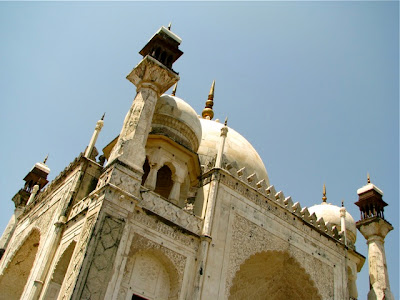
Bibi ka Maqbara
Granted the Bibi ka Maqbara was built by Aurangzeb's son Azam Khan for his mother, rather than as any great monument of love for a spouse, I still find it deliciously ironic that the building attempted to copy the Taj, a monument which Aurangzeb reportedly found distasteful for the amount of money spent (or wasted, as he would have had it) on its construction.
No building, of course, can even compare to the Taj.
The Maqbara is but a poor attempt - too narrow, the dome looks rather bulbous as a result, the four outlying pillars are far to blocky and broad. The dome is of marble and marble also decorates the very bottom of the monument, but it's almost as if the makers ran out of funds to overlay the remaining middle in marble (perhaps they did) and painted it a chalk white. It is still an interesting and significant piece of Mughal architecture and would possibly have demanded much greater praise, if it weren't for the parallels it so obviously draws.
Aurangzeb's grave
Aurangzeb's grave on the other hand is hauntingly simple - still, as Aurangzeb had himself willed, open to the skies. Loath to use treasury funds for the tomb, he asked that no more than 8 rupees be spent on his tomb, the money collected from the sale of the caps he stitched and the Quranic verses he calligraphed. The marble grill was added only in early twentieth century, when Lord Curzon, the then Viceroy, visited and was appalled to see the state of the place. It is still difficult to believe that royalty lies here, let alone the Mughal emperor who ruled India for the longest and at its largest.


6 comments:
thank you for taking us on such a fascinating trip, dear SZ... the second picture is so captivating. is that arrangement part of the tomb? i don't understand very well what it is, a branch as an offering?
Just saw your comment about Aurangzeb.
I am certainly guilty of believing populist (textbook) history about the man. Are there books/studies which show him in a different light?
Roxana, I have quite honestly not seen a grave like this one before. Most of the royal toms are these elaborately carved marble ones. The sheet is just to protect the grave and from what I gathered there wasn't any significance to the plant as such, but perhaps it had been planted to keep the soil in place and as an offering.
km: You know, I really couldn't recommend Abraham Eraly's Mughal Throne highly enough. It's an excellent introduction.
Thanks for these photos, they brought back memories of my own visit to Aurangabad, Rauza, Khuldabad in late '07...superb shots...
Re: Aurangzeb: there's no contradiction: he was personally the least violent, most "law-bound", of the Great Mughals -- and politically the least tolerant of non-Muslims, the most orthodox Sunni, and the most suspicious of Sufism. Not for him the young Akbar's appropriation of other men's wives -- but those acts affected a few people, whereas Aurangzeb's worldview affected the realm at large.
thanks Qalandar. No disagreement re: Aurangzeb, the point I was making was that in popular history we still get a very un-nuanced picture of the man and of his rule.
Post a Comment